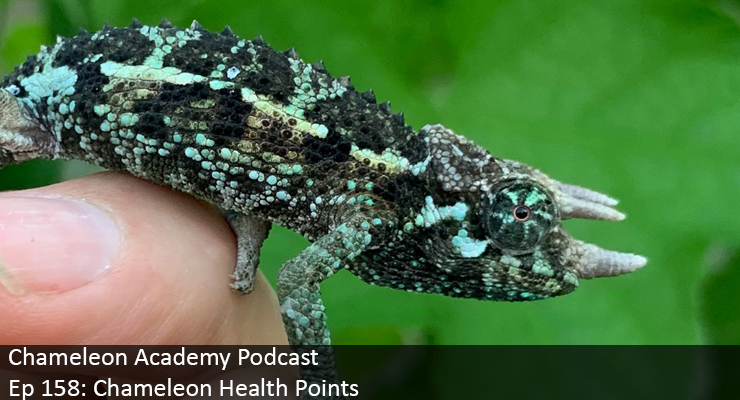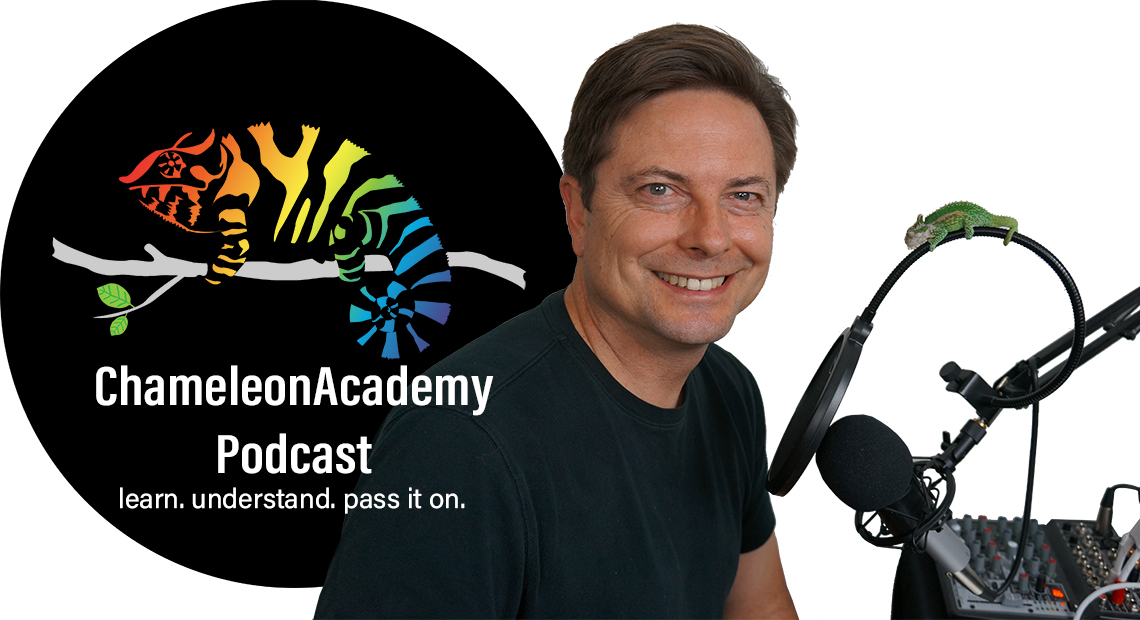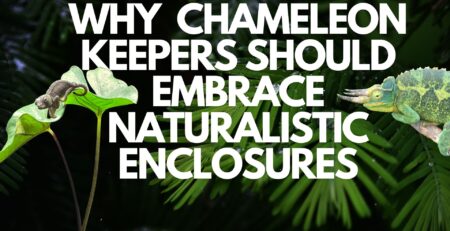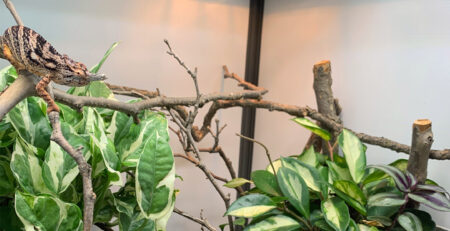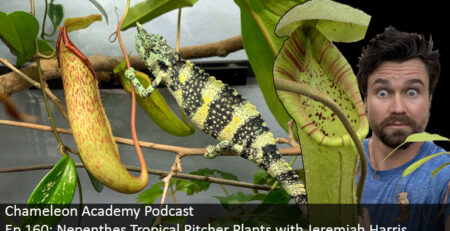Ep 158: Chameleon Health Points
Listen Here!
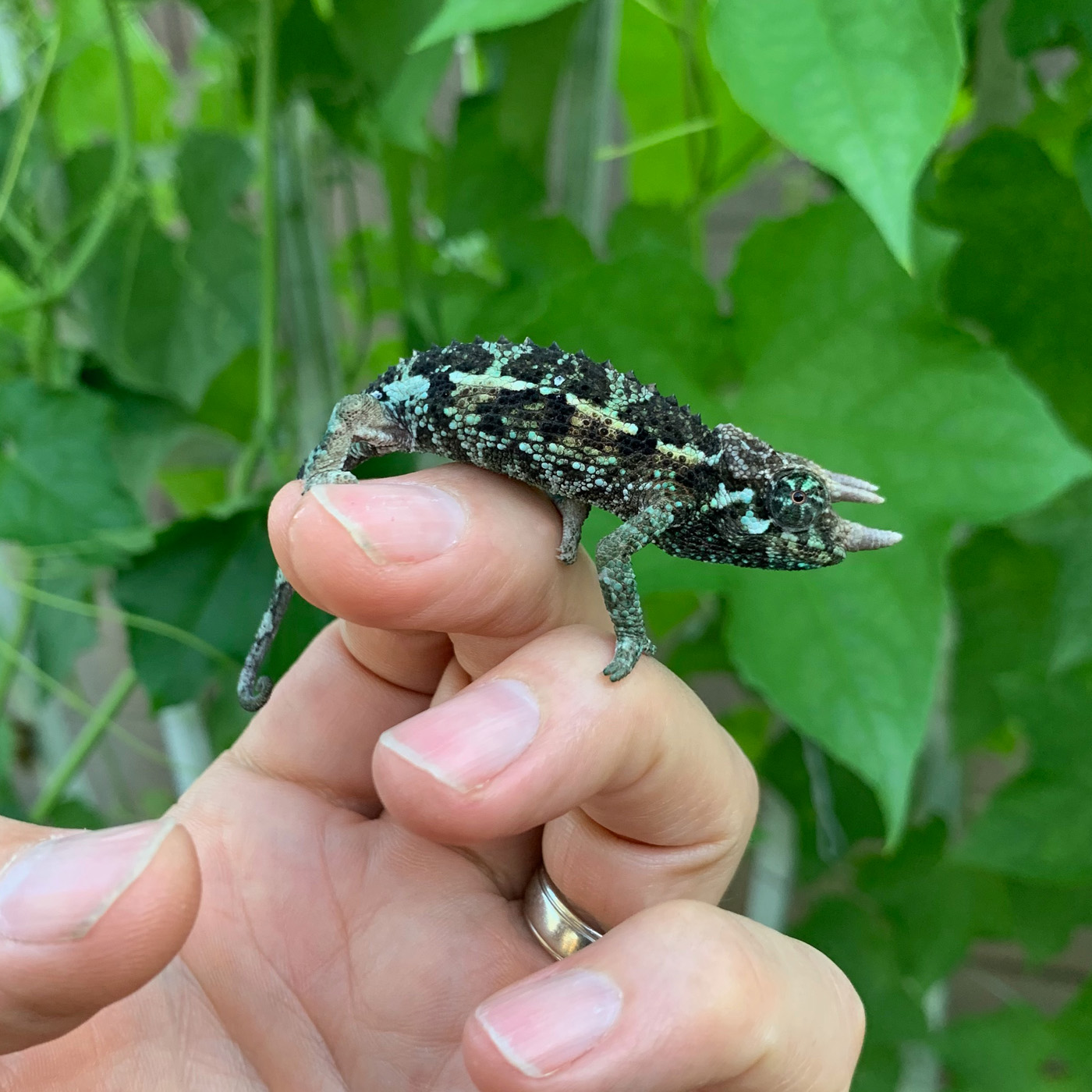

Bill Strand
Ep 158: Chameleon Health Points
Chameleon husbandry is made up of many aspects including environmental conditions, nutrition, and emotional security. Everything we do that gets our husbandry closer to the optimal conditions strengthens our chameleon. Everything we do that is off weakens our chameleon. Today I talk about the cumulative effects of stress and how we should look at each one of these husbandry parameters.
Transcript (More or Less)
Chameleon husbandry is made up of many, many interlocking pieces from lighting, heat, air circulation, nutrition, hydration, emotional health, and the list gets quite lengthy when you start getting more detailed. And it isn’t just getting the individual values right, it is getting the values right in balance with the other values being right at the right time in the day and life. Wow, with such restrictions, how, in the world, can a chameleon survive in the wild?
Well, because they were not just thrown into the wild. They evolved within those wild conditions. And they grew to both work with and rely on those natural conditions. They have their instincts set up to allow them to negotiate within certain ranges of conditions and to move their bodies to fine tune their life experience.
The reason why they got the reputation of being delicate was that we took them out of this system they were optimized for and plopped them into completely foreign conditions and are requiring both their bodies and their behavior to adjust to and work within something completely different.
And it is our job to try and match the cage conditions as close as possible to the natural conditions they are built for. We start with a macro understanding of the home environment, meaning the weather patterns taken from some weather station somewhere in the general geographical vicinity and try to apply that to our cages. But they live in a rich network of microclimates and while the weather station may read 90 degrees F, the chameleon may be hiding deep in the shade where it is cooler. And they certainly do not bask at mid-afternoon UVB levels, so we rely on people who can relate the chameleon’s behavior first hand so we can extract what the chameleon may be using and what it may be escaping as far as the environment. Temperature, humidity, UVB, nutrition, security,….
Your chameleon’s health is the sum of all these values. If they have a cold night and get deep sleep then they get five health points. If the humidity was low during the night and they got dehydrated they lose three health points. If water is provided to them in the morning they gain two health points, but not the full three because they went through the dehydration. They see a chameleon in their cage and the chameleon is bigger than they are and is blocking their way to the feeder bowl and they lose five points in stress. The last feeder left that they did snag was well fed and powdered with calcium and that gives them a positive point. The UVB bulb gives them UVB, but is very high level so 2 points for getting vitamin D, but losing a point for the body being stressed from defending against the intensity. And it goes on and on. Points given for conditions that match their ideal and points removed for things that don’t. Of course, this plays out every day in the wild, but, remember, in the wild they are under conditions that they have adapted to. We remove predators and parasites, but give them air conditioned air and a heat lamp in place of the sun. We give them all the vitamins and minerals we can think to throw at the wall, but we give them in amounts and balances that may or may not require the body to work overtime to process. So the point is that each one of these husbandry aspects adds or subtracts from your chameleon’s health. When our chameleon gets sick, sure, it can be because of one overwhelming thing such as a temperature spike into triple digits or being left in the direct sun for a couple hours. But think of how many times you have seen bacterial infections. Bacteria are all around us and the chameleon’s immune system is constantly fighting it off. A bacterial infection occurs when something happens which weakens the immune system. This can be a break in the skin where there is a sudden surge of bacteria where there shouldn’t be, but something like a respiratory infection is generally when the immune system is weakened and cannot fight off the bacteria that are breathed in. The immune system weakens when their health points are below a certain level.
So, where am I going with all of this? I want to explain that this is why a full husbandry review is necessary when determining why a chameleon is sick. We would love to think that there is one smoking gun. The temperature. The UVB. The cage set-up. And it is very tempting to find the first thing that doesn’t match our caresheet, call it out, and exit victorious. And, while it is true that we can often find one huge discrepancy it is important that we find all the issues in the husbandry. That one huge item we found, be it the temperature was too high or the supplements could be off, may have been the major thing that pushed the chameleon over the edge, but there could be a handful of other things that helped nudge it to the forefront.
In addition, if you are doing something that goes against conventional husbandry wisdom like keeping chameleons together or not giving a nighttime drop to your montane chameleons, you need to know that the effects of doing that are cumulative over time. You can get away with it for a while. If we use the “health points” analogy, if there is not enough nighttime drop for deep sleep you may lose 2 health points for the first week, 5 for the next week, and 10 for the next week. The first day or two living in the same cage with a dominate chameleon will be just a stress spike. After a week it becomes constant stress. The deceptive situation is that you are not seeing this slow degrading of the immune system. And then, out of nowhere, your chameleon gets an infection. That is the point where all these trivial husbandry issues summed up together to become negative and the immune system could not compete with the bacteria or fungus or whatever is attacking.
Two big culprits of cumulative stress are cohabitation and nighttime drops. The reason these husbandry issues continue are because we want what we want. We humans want to have at least a pair, but would love a herd, of chameleons in one cage. Despite decades of experienced keepers saying don’t do it and it being an unnatural condition, we cannot escape that we want to believe chameleons can be kept together. And there is always someone who wants to give that part of us hope and keeps chameleons together. And it appears to work. And as long as the chameleons are under these conditions the health points slowly ebb. But this is not visible. And when things finally go downhill it is due to respiratory infection or some other condition due to a weakened immune system. Folks, all of us saying not to do it are not saying that because we haven’t tried. We aren’t saying it because we just aren’t smart enough to figure it out. We are saying it because of decades of watching it be tried and failing. There is no power conspiracy here. Just be careful of the relentless loss of health points as stress spikes become low grade, but chronic, stress
Nighttime drops are another one. Especially for Jackson’s Chameleons. Our caresheets require ambient daytime temperatures in the low to mid 70s and a nighttime drop to the low 60s or 50s. Inevitably, someone brings up Jackson’s Chameleons establishing themselves in Hawaii and saying that the temperatures do not match what they survive in Hawaii. First, I want to say, if you are going to model your husbandry after a set of wild habitat parameters, use the land they spent their entire pre-history existence evolving to live in. Do not use a geographical area that they have been introduced to and the new land’s conditions happen to fall within the chameleon’s tolerance range. Saying that a chameleon can survive conditions other than its homeland is only showing their tolerance range, not their ideal range. And, yes, they have reproduced in Hawaii ad nauseum. So what is going on here? The same thing that goes on in our cages. They are in a constant condition of gaining and losing health points. They are finding cooler microclimates inside leafy trees and they are losing health points if they do not sleep deeply. You can still reproduce even when you are not on the top of your game.
We could go round and round about what the adaptation to Hawaii means, but my specialty is captive husbandry. And I will tell you that in the confines of the cage space we have available to us, the important parameters are not the macro conditions, but the microclimates that they spend their time in. It is not the conditions they can tolerate, but the conditions that nurture them. And determining these microclimate conditions is not easy at all. How much UVB does a chameleon expose itself to? At what combination of temperature and humidity and sun exposure does overheating occur? For these kinds of things we take our starting points from nature, but we have to experiment in our living rooms. Because our cages are very little like the wild condition. We have a constant UVB that flips on in the morning, stays at a constant rate, and then suddenly disappears. Same with light. The humidity- it is often air conditioned out of the air. And breezes occur when someone opens a door, turns on a fan, or that air conditioner again. And, finally, they are restricted to a space of a 2x2x4’ cage to find their preferred microclimates. Yes, they may have higher temperatures than ideal in their adopted new land, or even in their homeland, but they have entire trees and bush thickets to find cooler microclimates. Yes, we try to give them microclimates in the cage, but why would you start out your gradient with a temperature that is something they are having to tolerate. You are wasting valuable space.
And why would anyone resist a nighttime drop? Any one that seriously works with these higher altitude species would say that the nighttime drop is necessary or even critical. Well, simply because it is hard for some of us to get that low at night. Instead of paying the money for an air-conditioning unit or having the discipline to pick another species it is easier to decide they really don’t need that nighttime drop. And each night they don’t get good sleep is health points trickling away. And this isn’t hard to understand. You know how we humans get when we don’t have a good night’s sleep. It isn’t pretty. Take some of our recent summer months. One sweltering night being so hot that you are sweating onto the sheets and can’t get sleep because of swatting mosquitoes and the bags under your eyes could tell stories. And after a week of sleepless nights you can’t decide whether you are the walking wounded or the living dead. Coffee is your best friend, but you are on a hair trigger temper. Yes, we survive, but every night you can feel your health points disappearing. Thankfully these heat waves go away and we get our health points back as we catch-up on our sleep again. And this isn’t just a game of logical leaps. You can tell how deeply your chameleon is sleeping. The warmer it is the lighter your chameleon sleeps and the easier your chameleon wakes up. You want your chameleon to have a deep sleep and that means cool, humid nights.
Like I said, the species that most gets the brunt of this ignoring of its needs is the Jackson’s Chameleon. If you have a Jackson’s Chameleon, I warn you against thinking it is okay to avoid a nightime drop. It will work for a while until they have worked through all their health points and then you get a Temporal Gland Infection…or your babies start dying off for no obvious reason. The two prime suspects in baby Jackson’s chameleons dying off: cohabitation and lack of nighttime drops. I can tell you from personal experience, when do I get a rash of infections? When we get the heat waves coming through Southern California. Life is perfect and Jackson’s thrive for most of the year. But when it gets hot the health points start to go the other way and a couple of infections crop up. I am on the look out and they get treated quickly. I have yet to lose one. And, really only one or two get them. So I could easily look at the ones that don’t and say they can handle the higher temperatures just fine. But that would be ignoring the overall trend that the instances of infections rise. And I have a big enough group that I can actually notice trends. Beware of getting husbandry advice that goes against the commonly accepted standards from people with one chameleon.
And, chances are that there is someone listening to this that will defend higher temperatures for Jackson’s Chameleons based on their interpretation of Hawaiian conditions. I only ask this. Before you make a logical argument that it is okay to keep Jackson’s at higher temperatures or without nighttime drops please try it out yourself in the captive cage environment and work out the issues. For those of us who have been working with Jackson’s over many generations and years we recognize that the nighttime drop and cooler daytime temperatures give the greatest success. This isn’t a game of what our chameleons can tolerate. It is a mission to determine what their optimal conditions are. I cannot think of any reasonable argument to include anything but the closest we know to optimal conditions when we give husbandry advice. So, when you bring up the Hawaii argument to say Jackson’s do not need a nighttime drop understand you are going to be shut down by the breeders who recognize you are suggesting sub-optimal husbandry. If you truly believe your position please put in the work we have and prove it over successful generations and side by side studies. I know that is a lot of work. But so much work has been put into supporting the need for a nighttime drop that it is appropriate that it take deliberate repeatable testing to modify that advice. That would expand our understanding of the species. Believe me, I would love to see that work done. But if you have just looked at numbers and have not gone through the effort of replicating what you are suggesting in the captive environment then go easy on your confidence in going against the best husbandry practices that we have come up with. We are always changing and growing. But we need to change and grow with a methodical approach. Get yourself some chameleons. Prove your idea correct. And then prove your idea wrong. If you can prove it right and can’t prove it wrong then you have a solid discovery to share with the community.
How about infertile egg production? That is a big one. Developing and then laying eggs is a major stress on a female’s body. Over feeding, over heating and then putting our female veiled chameleons through an egg production up to four or five times what their body is naturally expecting to do is a huge body stress. I wish we were farther along in dialing in the exact diet and temperatures, but many of us have been able to reduce or eliminate infertile clutches in our female veiled chameleons. My female has never had an infertile clutch. Unfortunately, she is still having much greater clutches than the target 20-30 so I am have not achieved the final goal, but it is easy to do by simply cutting back on how much you feed her and how hot you keep her. I am not giving you numbers yet because we are still working through what the numbers are. I do not suggest lightly the reduction of food and temperature because there is danger in too little and too cold and we have to find those limits. But I can tell you right now that the standard feeding and temperatures provided veiled chameleons right now are too much and too high. My caresheets are closer to where we need to be, but I know they are not the best numbers yet. As soon as I am personally confident that we have the right numbers I will change them. That needs to be done only after careful testing and replication of results. It will take time. But, excess weight and constant egg production of mega clutches, fertile or non, is an obvious chipping away of the health points.
Anything else? Well, how about our humidity cycle? Our homes do not do well with close to 100% humidity at night. So all these chameleons in screen cages have a tube of fog to sit under if the keeper attempts at all to give them humid nights. Of course, since chameleons have been shown to be able to grow up and grow to what we presently consider to be old age using daytime misting not much thought is given to giving them what they naturally expect. I think we will be very surprised at how long they will actually live once we give them back the couple of health points they lose every night they dehydrate. Sure, they gain them back, or most of them, when the chameleon drinks in the morning. But just the act of losing and then gaining is a stress on the body which will shorten the overall life of your chameleon. That’s just the way life is.
So, ignoring the expected temperature drops, forcing social time on a non-social beast, ignoring the natural humidity cycle. Providing UVB that is higher than is necessary. Over feeding and over-energizing our chameleons. Stagnant air. Drafty air. Too hot, too cold. All of these things take away health points.
Nutritious food, comfortable temperature ranges, constant hydration opportunities, a sense of security. These are all things that increase health points. The main point of this episode is to bring to light that each one of these husbandry items has a certain weight. Just because forgetting to replace your burnt out UVB bulb hasn’t killed your chameleon it doesn’t mean it hasn’t weakened your chameleon. Just because your chameleons have appeared to be living in harmony for the last six months doesn’t mean you haven’t been slowly reducing their immune system. It all adds or subtracts.
And this is why we dive into each species and learn their requirements and best practices. This is why we seek to determine what the optimal UVB level is for each species. And once we do that, we will go the next step of discerning what is needed for each life stage. This is our art and science. And if you love chameleons as much as I do, I invite you to get obsessive about what is optimal. So much of what I do here is refining things that aren’t necessarily broken. Someone might ask why we need panther chameleons to live more than five years. The answer is because they can. And all we have to do is do our job right as keepers. And I don’t mean get in fights with people with logical arguments over temperature ranges. I mean test things out and give hard repeatable benefits. One of our community’s greatest achievements in 2018 was the wide spread awareness of the naturalistic hydration approach. See episode 89. And 2018 was the first time much of the community learned that Veiled Chameleons are actually not from harsh dry landscapes and we got a first person account of the oases that they truly live in. Check out episode 86. In 2019 it was the establishment of UVI 3 as the effective UVI for Veiled and Panther Chameleons. See episode 131. Pete Hawkins, Jonathan Hill, and I established that as a repeatable milestone. I also started working on awareness that we need to watch out for excessive UVB levels. See episode 127. 2020, this year, we have seen a breakthrough with incubation diapause from Frank Payne, (that was the episode for April 15, 2020) and serious work towards reducing clutch size and infertile clutches of female Veiled Chameleons with Mari Joki and people working with Petr Necas. (episode for April 6, 2020). Every year we are working on refining our husbandry and reducing the loss of health points. And, yes, we still have so much further to go. But that is why we need people willing to put in the work doing side by side studies. Talk is cheap, unless it is reporting hard work. The encouraging thing is that, as you can see, we are moving forward. Every year, for the past few years, we have made substantial steps forward as far as husbandry. And, if this podcast has anything to say about it, we will continue to make breakthroughs.
I’d like to thank you for joining me here. Thank you for joining me for these many years of podcasting about our chameleons and chameleon community. It doesn’t look like anything is slowing down. So buckle up and let’s see where we can take the art of chameleon husbandry!

